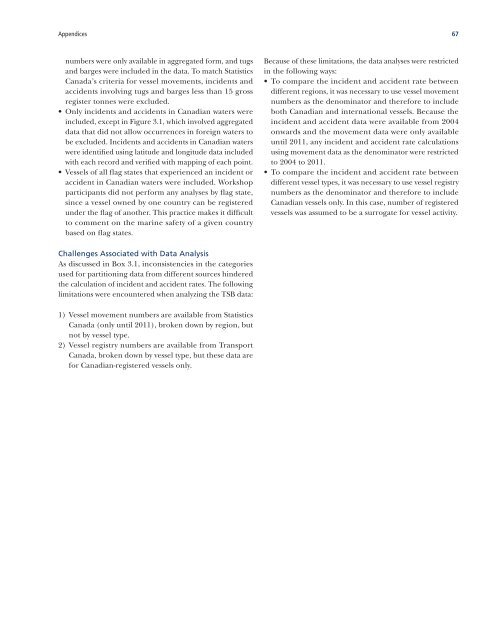Commercial Marine Shipping Accidents Understanding Risks Canada
cca_marine_shipping_risks_en_fullreport
cca_marine_shipping_risks_en_fullreport
You also want an ePaper? Increase the reach of your titles
YUMPU automatically turns print PDFs into web optimized ePapers that Google loves.
Appendices<br />
67<br />
numbers were only available in aggregated form, and tugs<br />
and barges were included in the data. To match Statistics<br />
<strong>Canada</strong>’s criteria for vessel movements, incidents and<br />
accidents involving tugs and barges less than 15 gross<br />
register tonnes were excluded.<br />
• Only incidents and accidents in Canadian waters were<br />
included, except in Figure 3.1, which involved aggregated<br />
data that did not allow occurrences in foreign waters to<br />
be excluded. Incidents and accidents in Canadian waters<br />
were identified using latitude and longitude data included<br />
with each record and verified with mapping of each point.<br />
• Vessels of all flag states that experienced an incident or<br />
accident in Canadian waters were included. Workshop<br />
participants did not perform any analyses by flag state,<br />
since a vessel owned by one country can be registered<br />
under the flag of another. This practice makes it difficult<br />
to comment on the marine safety of a given country<br />
based on flag states.<br />
Because of these limitations, the data analyses were restricted<br />
in the following ways:<br />
• To compare the incident and accident rate between<br />
different regions, it was necessary to use vessel movement<br />
numbers as the denominator and therefore to include<br />
both Canadian and international vessels. Because the<br />
incident and accident data were available from 2004<br />
onwards and the movement data were only available<br />
until 2011, any incident and accident rate calculations<br />
using movement data as the denominator were restricted<br />
to 2004 to 2011.<br />
• To compare the incident and accident rate between<br />
different vessel types, it was necessary to use vessel registry<br />
numbers as the denominator and therefore to include<br />
Canadian vessels only. In this case, number of registered<br />
vessels was assumed to be a surrogate for vessel activity.<br />
Challenges Associated with Data Analysis<br />
As discussed in Box 3.1, inconsistencies in the categories<br />
used for partitioning data from different sources hindered<br />
the calculation of incident and accident rates. The following<br />
limitations were encountered when analyzing the TSB data:<br />
1) Vessel movement numbers are available from Statistics<br />
<strong>Canada</strong> (only until 2011), broken down by region, but<br />
not by vessel type.<br />
2) Vessel registry numbers are available from Transport<br />
<strong>Canada</strong>, broken down by vessel type, but these data are<br />
for Canadian-registered vessels only.


